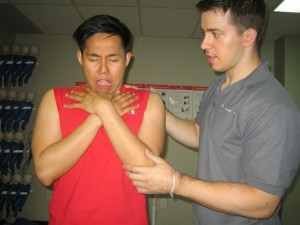Foreign Body Airway Obstruction or commonly known as choking occurs when a person’s airways are blocked off by a food or other objects. This can be partial or complete blockage causing difficulty in breathing or prevents a person to breath effectively. Most of the time, the blocking object can be expectorated or coughed out by the victim. If this does not happen, one should assess at the soonest possible time to see how one can help. First aid measures would depend on how serious the situation is whether the victim in an adult, a child or a baby.
A victim who is choking can still breathe if the airway is partially obstructed. However, this incomplete obstruction can be life threatening if his oxygen is not sufficient in the body.
One can stop breathing and become unconscious especially in case where there is complete obstruction of the airway passages.
Common Causes of Choking:
- Poorly chewed food especially large pieces
- Eating too fast or talking and laughing while eating
- Running and playing while food or object is in the mouth
Increase Risk for Choking:
- Severe croup
- Seizures caused by fever
- Inflammation of the epiglottis
- Congenital condition such as Cleft palate
- Obstructive airway diseases such as asthma, bronchiolitis
Symptoms of Choking:
- Universal sign would be holding his hands on his neck
- Difficulty of breathing
- Inability to talk
- Weak or at times ineffective cough
- Stridor or noisy breathing such as sounds during inhalation which can be high pitched or no sound at all
- Cyanosis or skin, nails or lips turns blue
- In severe cases, loss of consciousness

Delivering First Aid to a Choking Victim:
Recommendations of the American First Aid on Choking
- Call for help
- Ask patient for consent to do procedure
- Alternate the five (5) blows and five (5) thrusts until the object is expelled or the block is relieved.
What is the Blow for Choking?
- Make the person bend forward and giving 5 back blows using the hand (heel) – deliver this between the shoulder blades of the victim
What is the Heimlich Manuever for Choking?
- Wrap your arms around the waist of the victim by standing at his back
- Position your hand in a fist like manner just above the patient’s umbilical area
- With the other hand, grab the fist and make a rapid and upward thrush or push. It is like trying to lift the person
- Perform five (5) thrusts
Other Tips for Choking
- For partially obstructed airway:
- Back blows are not advised on this situation
- Ask patient if the is choking to determine if block is complete
- Comfort the patient
- Encourage him/her to expel foreign body by coughing
- If he cannot expel the foreign object, call an help
For total airway obstruction:
-
- In a conscious patient, place him/her in a standing or sitting position and slightly leaning forward, with the hand (heel), give the back blow. If unsuccessful, give five (5) thrusts. Do this five on five technique until the foreign object is expelled. If I cannot be expelled, call for help.
- For unconscious patients, try to give two (2) rescue breaths by tilting the head and lifting the chin upwards, and then shut off the nose by pinching. Seal the victim’s mouth by covering the mouth and breath. Blow to make the chest rise. However, if the breaths do not go in, tilt the head farther back and try 2 rescue breaths again. If the chest does not rise, you must give thirty (30) compressions. Note: each breath should last for a minute
Treatment for Choking Victims:
- There are ways of treating a choking victim. The start of the treatment is upon the arrival of the local emergency team.
- Intubation is performed by inserting an endotracheal tube to the trachea to see what is causing the obstruction. When the object is seen, a tool is used to remove the obstruction.
- Some instances, crichotomy is done if intubation is not successful. Crichotomy is a procedure when one makes a whole in the trachea thru the Adam’s apple. Then a tube is inserted to see the obstruction.
- Others use the bronchoscope which is a device inserted in the trachea. And if the obstructed object is seen, there are attachments to the bronchoscope for easy removal.
- If all these fail, the victim will be taken to the operating room for removal of the obstruction.
